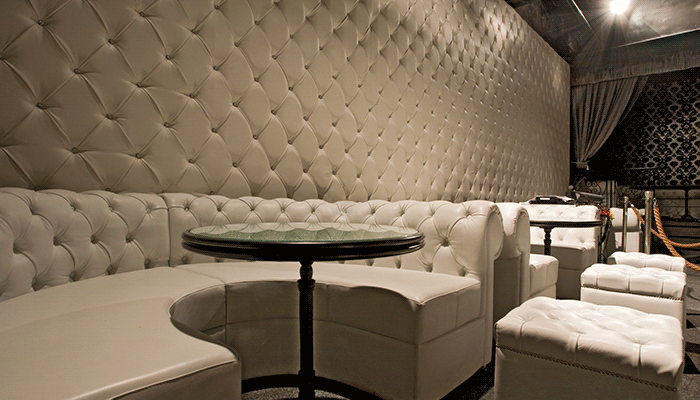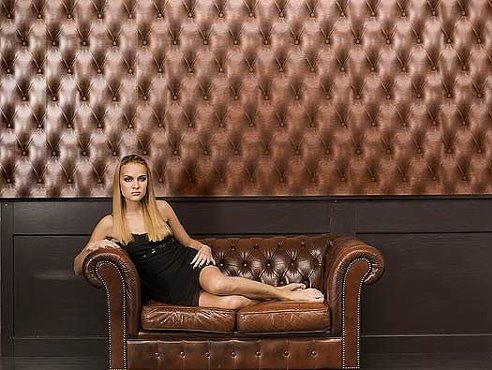Beautiful, sophisticated, stylish interiors are created using fabrics that are separated by the walls. Combining them with other materials, designers create luxurious decoration for premises. It is believed that this work is under the power of only professionals. In this article we will try to convince you that the walls of the walls can be performed with their own hands.
Content
Where use fabrics as finishes
Fabric - specific material, it is advisable to use them for wall decorations in:
- bedrooms;
- living rooms;
- cabinets.
But in the hallway, in the kitchen, in the children's room, such a finishing material, like fabric, undesirable, is difficult to clean them, and these are those places where the walls are rapidly polluted.
Advantages and disadvantages
Fabric coverage has many advantages:
- it is beautiful and aesthetically;
- masks disadvantages of walls and wiring;
- allows you to save heat;
- absorbs sounds;
- natural fabrics make the walls with breathable;
- it is elastic, so the shrinkage does not affect the quality of wall decoration;
- if the cloth is wide, then not visible seams;
- the finishing process is not accompanied by a large number of construction garbage.
And to the disadvantages of wall decoration, the cloth refers:
- that it is more complicated than wallpaper;
- not easy care.
What fabric to choose
In general, it is possible to separate the walls by any cloth:
- genuine: flax, silk, cotton, jacquard, parol, atlas;
- artificial, i.e. viscose;
- mixed. This is when silk, wool, flax are added to cotton;
- synthetic where polyamide, polyester, polypropylene belong. Material for the release of synthetic tissue used for wall decoration is a modified non-combustible synthetic fiber. Peeling is not formed on it, it does not occur, does not save static electricity and dust, it does not fade.
Choosing the fabric you need to look at such characteristics:
- how it behaves under the influence of sunlight. Will not burn out after a while;
- whether it was a special processing that increases its service life;
- does not tire with drawing with its brightness;
- does hardening in the form of a foam rubber on the back of the tissue base.
For example, fabrics Belgian Bekaert Textiles, which differ:
- the simplicity of work on their wall mounting;
- do not require special care;
- lack of smell;
- dense weave of jacquard drawing and the presence of teflon coating, which makes fabric invulnerable before mechanical damage;
- resistant to moisture. BekaRt Textiles with even bath and saunas fabrics;
- a huge number of colors, shades and design solutions. The decoration of the walls with a cloth, the photos of which are placed below, is made just from the material from Bekaert Textiles.
Quality and Swiss fabrics from Creation Baumann, characterized in:
- special strength;
- sophistication applied with a laser, drawing;
- multiple shades;
- The presence in the Dimmer Sky fabric collection with the starry sky effect.
Keep in mind: Buy fabrics a little more than it is required by calculation, perhaps, after the incident of the year or two, some kind of site will have to be restored.
Finishing wall cloth with your own hands the most common way
Separate the wall with a cloth in several ways.
Ways to finish
There are such methods with which they decorate the walls with a cloth:
- fucking This way is most often used;
- upholstery;
- drapery;
- decorative niches;
- applique;
- shirma zonic.
Preparing the walls to pasting fabric
The method of finishing walls with a cloth, which we now consider, is used most often. They usually finish not all the walls in the room, and 1 or 2, or at all, separate some section of the surface, therefore, they emphasize on the picture placed there or TV. Before the walls of the walls with cloth, technology is provided for the preparation of the surface to be finished. Preparation is needed to eliminate large visible defects:
- we take a steel spatula and carefully cleaned the wall over the entire area. If the wall was whiten of lime, then first wash it with water;
- cooking a solution for plastering and fill it all deposits, including traces of nails;
- we give dry, and in the meantime you cook newspapers or thin paper, then we stick this waste paper on the wall, carefully smoothing. We give paper to dry and gluify the surface, eliminating irregularities using sandpaper;
- the spots available on the wall are covered with nitroloma, which will exclude their manifestation through the fabric.
We work with a cloth
If the material is planned to glue to the top, then it is necessary to beat off the line under the ceiling. It's just done:
- the rope is rubbed by any pigment;
- stretches at the desired level;
- The line is littered, and then parallelism is checked with a level.
Next, we carry out the fabric itself:
- we check it on the shrinkage, wet first a small segment, if after drying, it will decrease, then soak all the fabric, then we are drowned and stroke. This procedure is called decotting;
- next, we cut the cloth with strips whose length is equal to the height of the wall, of course, while we leave the stock;
- we measure the length of the wall to be pasted and stepping among themselves the obtained bands. As a result, a cloth addictive to the whole wall should be obtained;
- climb the seams and turn the cloth into the roll;
- for further work, you need an assistant. Fracture glue, well, at least "bustilat" or caseinov, a wall from one edge to a width of centimeters 10;
- slightly deploy the cloth rolled into the roll and apply it to the end to the glue strip. Side, at the top and bottom there should be a small allowance. While you hold the roll, the assistant roller smoothes the glued area. On one glue, the fabric may not be held, so it is desirable to progress, having stuck a temporary rail on it, but I don't drive the nails completely, the gap remains between the hat and the wall;
- apply the same strip of adhesive to the upper boundary wall. One participant in the process roll unwinds and the other sticks cloth, pressing it with a roller. If the material is heavy, then again fills rail;
- we wait until the glue dries and continue: sticking the same technology first remaining edge, and then the bottom. The fabric, with good stretch the;
- after complete drying of the adhesive, remove, if used at all, reiki. Remove the nails very carefully with pliers;
- cut the allowances sharp blade;
- it remains only to arrange the edge of the baseboards, moldings or baguettes.
Important: in places where the glue is applied, even on the day after the gluing, the air bubbles may appear in the fabric. To remedy the defect, pierce them with a needle, and then iron the iron.
The above method has one drawback: the cloth attached hard and if you need to wash it, then take it off is difficult, but the next time the method of fastening tissue, the question of washing easier.
Wall upholstery fabric
Padding or even call this method, close-fitting, similar to the installation of suspended ceilings, so need a framework. His becoming ready or made themselves out of wooden slats or corner. Purchased and frames are plastic, and rubber.
to construct the frame
For frame structures, we need:
- wooden strips 50-70 mm width 10 mm thickness;
- nails or screws;
- screwdriver or hammer.
frame assembly:
- if the wall is concrete or brick, then drill a hole in it for fastening straps;
- fasten all the horizontal bars: the ceiling, near the floor, over the doors and windows. The edges of the fabric will need to hide behind strips, therefore, a gap of 3 mm below the ceiling and above the floor;
- vertical slats assemble since the angle at a distance from each other of 0.5-0.6 m.
Upholstery
After manufacturing the frame, proceed to the upholstery:
- we are moving from the ceiling angle. Sewn and ironed fabric hooking up furniture staples or nails. The minimum distance between the fasteners - 50 mm maximum - 100 mm;
- folder is leaving 2-3 cm;
- during the stretch the fabric with a fairly large force;
- we take a plummet and check the verticality of the cloth;
- We nailed the canvas from the bottom, making sure to not formed folds;
- we take a screwdriver and dressed with the upper and lower edges of a bar.
If you mess around with wooden frames do not want to, you can buy ready-made profile - PVC. It is expensive and it is usually fastened fabric of polyester.
The most convenient way to fasten the fabric on the wall
The wash and cleaning of the fabric will help without special efforts.
- we assign one tape on the wall;
- on the involvement of the panels also secure a sticky tape and combine with the one that on the wall.
Antique wall finishing technology with cloth
The walls of the walls with a cloth, the technology of which was borrowed from the masters involved in the carket finish, and called: Kareny. It does not just make the walls stylish and beautiful, but also makes noise insulating and insulate the room. So, we define right away: the material takes only dense and:
- on the surface of the wall stick noise and thermal insulation material;
- next, draw a sketch. It is necessary in order to determine how much material is required for upholstery and how much you need to make fasteners. The screeds themselves can be carved both from the same material that is used for tightness and allocate them by making contrast;
- on the cloth, by observing accuracy, make a mark where we will beat nails;
- fasten the top of the fabric;
- we apply fasteners on the canvas and fix them with furniture nails;
- due to the fact that the bottom is soft material, the drawing will be convex. The stylistic conversion of the design of the room will be attached to the same armchair and sofas.
Here you will clearly see the process of finishing the walls with a cloth, whose video is a fragment from the popular TV shows "Apartment question":

























